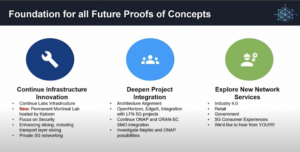The 5G Super Blueprint initiative is a community-driven integration and proof- of- concept involving multiple open source projects that enable end-to-end use cases demonstrating implementation architectures for end users. Intending to accelerate deployment (e.g., from six months to six weeks), the 5G Super Blueprint provides the framework for implementing real-world use cases in the open.

Integrating multiple open source projects and umbrellas (such as LF Edge, Magma, EMCO, Nephio, CNCF, O-RAN Alliance, and Linux Foundation Energy) with a full-stack framework for underlying infrastructure and application layers across the edge, access, and core, this initiative is a true “Integration and Interoperability” framework across the ecosystem. Specific use cases include fixed wireless, mobile broadband, private 5G, multi-access, IoT, voice services, network slicing, and more (many of which are now in active production deployment). In short, the 5G Super Blueprint is a vehicle for collaborating and creating end-to-end 5G solutions. Currently, the U.S. government is the leading user of these blueprints across all major case studies, including Static Transport Slicing, Distributed DOS, and Factory Visual Inspection (check out this summary of how DARPA is using the 5G SBP).
Another example of the 5G Super Blueprint in action comes from a Japanese enterprise customer who collaborated with LFN member organization, Aarna Networks. The collaboration delivered a Radio Access Network (RAN) core and single pane of glass for an enterprise customer to view, orchestrate, configure, and manage private 5G mobile broadband and IoT deployment.
The LFN community continues to innovate and evolve the 5G SBP from its very first incarnation at the OPNFV Summit in Beijing, 2017. The focus this past year was on extending the 5G SBP to include an edge use-case using an AI trained to detect non-compliant safety equipment during a live test (catch the 5G SBP keynote demo video from last year’s ONE Summit).
The 5G SBP infrastructure is now permanently housed in LFN member company Kaloom’s facilities in Montreal, Canada, and deployed as needed in other locations for future use-cases which are currently in development. Additionally, the infrastructure can be used to showcase more use-cases from other projects under the Linux Foundation, and we expect additional blueprints to derive from the initial 5G focus as the initiative continues to evolve, so stay tuned!